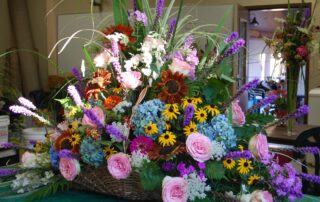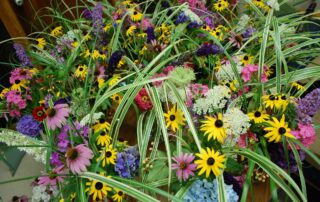 Pillar: Reverence
Pillar: Reverence
Laudato Si’ Action Plan Goals: Ecological Spirituality
 Pillar: Reverence
Pillar: Reverence
Laudato Si’ Action Plan Goals: Ecological Spirituality
Group (Grade Levels): All levels
Learning Goals:
- Experience and appreciate the beauty of flowers as part of God’s soul-inspiring creation
- Experience diverse elements forming an integrated whole
- Experience an “aha!” moment of beauty through floral arrangements
Materials Needed: greens, flowers, clippers, bucket for collecting, vases or other containers, water, oasis if applicable, floral tape, floral knives, workspace, trash container
Estimated Time to Complete Activity: 2 hours
General Outline of Experience
- Proclaim the Scripture passage, Matthew 6:27-29 and lead a brief discussion: “And which of you by being anxious can add one cubit to his span of life? And why are you anxious about clothing? Consider the lilies of the field, how they grow; they neither toil nor spin; yet I tell you, even Solomon in all his glory was not arrayed like one of these.”
- What is the purpose of flowers? Why did God make flowers in creation?
- Close with the prayer “Canticle of the Sun”: “Praise be to you, my Lord, through our Sister, Mother Earth, who sustains and governs us, and who produces various fruit with colored flowers and herbs” (“Canticle of the Creatures,” in Francis of Assisi: Early Documents, 1, New York- London-Manila, 1999, 113-114).
- Consider using other references to flowers and beauty found in the Auxiliary Activities/References section, either at the gathering or during the activity.
Encourage participants to picture or think about these questions:
- Where will the arrangement be placed? What size? What colors?
- Present slideshow of a variety of arrangements in different settings.
- Have each participant choose a container for his/her arrangement.
- Collect/pick flowers and greens outside or from already cut flowers.
- Demonstrate to participants how to cut flowers for arrangements (how to hold the knife, use clippers, cut flowers by slicing the ends at an angle of about 45 degrees).
- Demonstrate how to prepare a bed of greens, to provide support for the flowers.
- Demonstrate how to choose and arrange flowers: The height of the flowers should be in proportion to the size of the container; pay attention to the colors and textures.
- Have participants now choose greens and flowers for their arrangements.
- Have them each create an arrangement.
- Encourage interaction and peer review, seeking others’ opinions and advice.
- Have each participant share with the group their intended place or destination for the arrangement.
- Encourage participants to turn/walk around the room and admire the beauty of each one’s creation.
- Proposed discussion questions:
- Why did you choose the flowers you chose?
- What did you learn about yourself?
- What is the importance of having diversity, not only in flower arranging but also in life?
- How can you bring more beauty into your life and the lives of others?
- Potential analogies
- The experience of beauty = experience of the awesomeness of God.
- Flower arrangements are analogous to variety in human relationships, including how the individual flowers come together into a whole that is beautiful in itself and which inspires awe and contemplation.
- Flower arrangements are analogous to the diversity of talents that we all have and the reverence we should hold for each person’s unique gifts and talents.
- Experiences from the life of St. Francis:
- “How great do you think was the delight the beauty of flowers brought to his soul whenever he saw their lovely form and noticed their sweet fragrance? He would immediately turn his gaze to the beauty of that flower, brilliant in springtime, sprouting from the root of Jesse. By its fragrance, it raised up countless thousands of the dead. Whenever he found an abundance of flowers, he used to preach to them and invite them to praise the Lord, just as if they were endowed with reason” (The Life of Saint Francis by Thomas of Celano, The First Book, in Francis of Assisi Early Documents I, The Saint, p. 251).
- “He (St. Francis) commands the gardener to leave the edges of the garden undisturbed, so that in their season the green of herbs and the beauty of flowers may proclaim the beautiful Father of all. He even orders that within the garden a smaller garden should be set aside for aromatic and flowering herbs so that those who see them may recall the memory of eternal savior” (The Remembrance of the Desire of a Soul by Thomas of Celano in Francis of Assisi Early Documents II, The Founder, p. 354).
- “. . . [H]e used to tell the brother who took care of the garden not to cultivate all the ground in the garden for vegetables, but to leave a piece of ground that would produce wild plants. Thus, in their season, they would produce “Brother Flowers” out of love for Him Who is called the “flower of the field” and “the lily of the valley.” Moreover, he used to tell the brother gardener that he should always make a beautiful flowerbed in some part of the garden, planting and cultivating every variety of fragrant plants and those producing beautiful flowers. Thus, in their time, they would invite all who saw those herbs and those flowers to the praise of God. For every creature says and exclaims: “God made me for you, O mortal!”” (A Mirror of Perfection, The Sabatier Edition, in Francis of Assisi: Early Documents III, The Prophet, p. 366).
- Laudato Si’ quotes
- “If we approach nature and the environment without this openness to awe and wonder, if we no longer speak the language of fraternity and beauty in our relationship with the world, our attitude will be that of masters, consumers, ruthless exploiters, unable to set limits on their immediate needs. By contrast, if we feel intimately united with all that exists, then sobriety and care will well up spontaneously” (Laudato Si’, n. 11).
- “What is more, Saint Francis, faithful to Scripture, invites us to see nature as a magnificent book in which God speaks to us and grants us a glimpse of his infinite beauty and goodness” (Laudato Si’, n. 12).
- “Authentic development includes efforts to bring about an integral improvement in the quality of human life, and this entails considering the setting in which people live their lives. These settings influence the way we think, feel, and act. In our rooms, our homes, our workplaces and neighborhoods, we use our environment as a way of expressing our identity. We make every effort to adapt to our environment, but when it is disorderly, chaotic or saturated with noise and ugliness, such over stimulation makes it difficult to find ourselves integrated and happy” (Laudato Si’, n. 147).
- “All creatures are connected, each must be cherished with love and respect, for all of us living creatures are dependent on one another” (Laudato Si’, n. 42).




